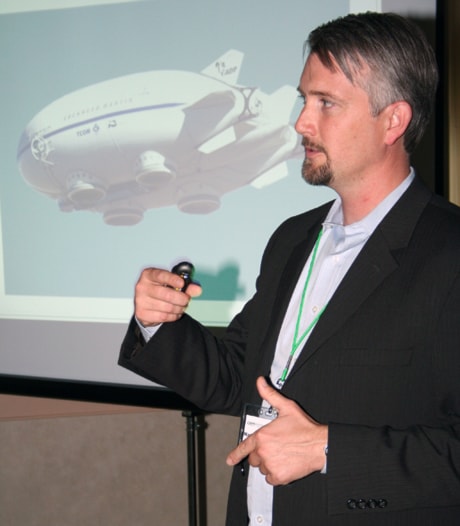Driverless cars? Massive airships hauling cargo across the country?
This could be the future of transportation in Canada, says Nathan Armstrong, president of Calgary-based Motive Industries Inc. And his predictions are as likely as anyone’s.
Motive Industries specializes in innovative transportation and design, working on projects for the likes of Honda, Audi and Toyota. Armstrong himself has spent a decade and a half in transportation design engineering and been involved in such projects as the International Space Station, Delta Rockets and the Joint Strike Fighter.
He’s worked on more than 30 production vehicles, 100 concept vehicles and nearly 1,000 clay, interior and scale models.
On Friday he was in Lacombe discussing the future of transportation during the Alberta Clean-tech Industry Conference.
One of his focuses was autonomous vehicles that are capable of manoeuvring with the help of sensors and GPS equipment.
A group of engineers from Brazil are currently using a solar-powered autonomous car to travel the 13,000 km from Italy to China, Armstrong pointed out. And at London Heathrow Airport another such vehicle is transporting people and materials around.
“I like this idea a lot,” he said, explaining that a person could punch in his or her destination and let their vehicle do the rest.
Solar power could also be used to propel giant airships, said Armstrong, with gases like hydrogen giving them buoyancy. His company is already working on a design that could lift up to 1,000 tonnes of cargo.
“Our plan is to build three of these things in Canada in the next five years.”
“We have lighter-than-air gasses. Why not use them?”
A related idea would be to tether airships onto a cable running across the Rocky Mountains. Not only would that keep them on a designated route, it would allow the aircraft to be winched down during inclement weather.
Further into the future might be flying cars, or “personal nanojets,” said Armstrong, adding that prototypes already exist.
In fact, he said, we already have the technology to develop a variety of advanced transportation alternatives.
“It’s just implementation of what we already have.”
Industry has been slow to adopt such changes as replacing the steel in cars with more efficient and environmentally friendly alternatives — like natural fibre composites using such materials as hemp.
“There was a study done a few years back that if you drive a 20-year-old vehicle, and it’s putting out a bunch of black smoke . . . it’s actually cleaner to drive that car for another 20 years than it is to buy a new car — the amount of energy it takes and materials it takes to make that new car.”
Transportation was one of eight topics discussed at the workshops in Lacombe. The Alberta Clean-tech Industry Conference was to continue on Saturday at Red Deer College.
hrichards@www.reddeeradvocate.com
